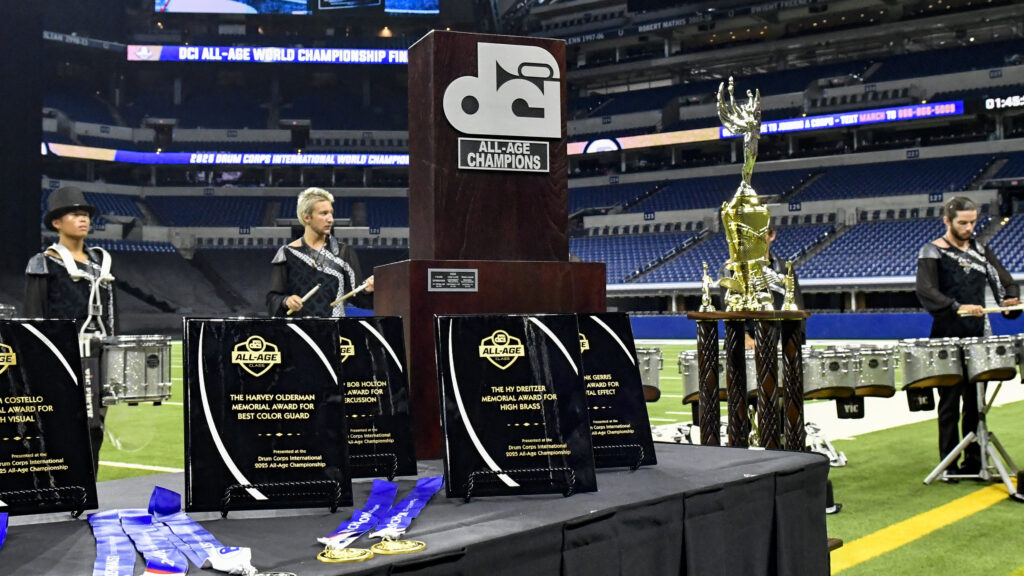The following are commentaries from two Fanfare readers about from where drum corps came and to where it is going. The first are excerpts from a letter sent in by Betsi Waldron.
I first saw my first drum corps long before most of you reading this were born. That may make me “old” by some standards, but the memories are still fresh. A recent “Fanfare” article stirred many of those memories and started me thinking about what so many of us who aged out over 15 years ago are all thinking … what happened to drum corps? It was 1968 and I was only 14 when I heard my local drum and bugle corps rehearsing at a middle school about three blocks from my home. To me, they were awesome … I had never seen or heard anything like it. However, they were a small corps, even by the standards of corps back then. With a little begging (OK, whining) to my parents, I joined the then fledgling Guardsmen Mt. Prospect, Ill. We were a “community” drum corps the way most corps were before members had to try out and fly into camps. It was truly a local activity sponsored for the most part by the local VFW or American Legion. We marched, but we didn’t smile or dance. We marked time. Does anyone do that anymore? Flags were carried in leather pouches called slings with metal cup inserts so you could hear if your “Right shoulder arms” was not on time. Well, I guess there are some things that are good about the evolution of drum corps. We rehearsed once a week all winter long and camps were reserved for two weekends in the spring, when you took all the parts you learned all winter and put them together with a drill — which was marched. As required by the rules of the time, you entered from the left end zone line, stayed within the end and side zone lines for at least 11.5 minutes and had to be off the right end zone line before 13 minutes. There was no walking out to your starting position, scurrying around the field and ending in your final formation. Most of the championships were preceded by the dreaded “inspection.” The entire corps was required to stand at attention while a military veteran came down the line and inspected every part of your uniform. All uniforms had to be exactly the same, except the guard could wear skirts (usually about 100 pounds of wool) that reflected the pants of the horn and drum line. During one such inspection, I remember getting warned by a preceding corps that they were even looking into the guard’s boots — yes, the little white ones — and if their socks didn’t match they would get a tic. And then you marched to your starting line and were off! That brings me to the tic method. What ever happened to that? It kept all corps honest in their musicianship. There were field judges that actually walked around with clipboards and would mark a tic for every error they heard. This was not only wrong notes, but missed attacks and releases, wrong articulations and differing stick heights. There was a marching judge. It was not all “appearance” as it seems to be now. Your lines were judged for straightness and accuracy resulting in a tic for each person not perfectly in line or knee-lift heights not equal. Yes, we actually marched! And there were penalties. Not just dropped equipment, but undertime, overtime, stepping off the side or end zones, talking, and a myriad of other infractions that all removed points from your score. There was no “pit.” All of the drums were carried — even the tympanis — and the entire drum line marched. They were all important parts of the drill. We didn’t have a “show.” That’s not to say what was put upon the field was not entertaining — absolutely the opposite. Even the smallest corps were entertaining and wholly supported by not only their own boosters, but other corps as well. There were GE judges that sat up in the booth. And only four captions of GE were judged: Guard, horn, drum and marching. There were no smiling or dancing captions. And touring was reserved for that week to ten days you spent getting to the National Championships, before the inception of DCI. There were no summerlong tours and the West Coast corps were only heard from at Nationals. There were no cook trucks; we ate fast food. And to the best of my memory, the equipment truck was a converted bus, not a fleet of semis. Buses were often just the school variety; no luxury reclining seats. And for co-ed corps, the buses were segregated … boys in one, girls in another. And what happened to some of those powerhouse corps that made that hair on the back of your neck stand up? 27th Lancers, Blessed Sacrament, Argonne Rebels, Royal Aires, Guardsmen, Crossmen and Spirit of Atlanta a little later? And the best show I ever had the privilege of seeing was the Santa Clara Vanguard in the mid-70s when they blew everyone away with “Young Person’s Guide (to Drum Corps)” and the famous Bottle Dance! Anyone who remembers that surely remembers 27th’s rifle line on their backs, spinning rifles with their feet! And Madison’s huge horn line (for the time) that would blow you back in your seat! I remember that we nicknamed them “God,” since that is all anyone could be heard saying when they came forward in a company front. I remember Guardsmen’s closer of “Greensleeves” that could make a grown person weep. I am not grumbling about the loss of flag presentations or concert setups, but there seems to be too much missing from what was drum and bugle corps. Military bearing, marking time, and game face are among those things that have gone astray. I believe it can still be done. I saw it done by the Blue Stars of 1978. An amazing drill that flowed from formation to formation, sometimes symmetrical, sometimes not, always including marking time, and excellent musicianship and color guard work. Drum corps has changed. I won’t be the sole judge as to whether those changes are all for the better. Those of you newer to the art/sport may never know the beauty, grace and dignity of “old time” drum corps, but there is a growing and vocal group who miss the old days. I will be at DCI DeKalb, but I also hope to attend some smaller shows to support those little guys that practice just as hard. I remember being the “little guy.”
Doug Oakley wrote in to talk about the history of drum corps and the quality of today’s product.
It never ceases to amaze me that competitors at the highest level, for the most part, have no idea about the history that led up to the current excellence seen on the field. I have talked to many members, parents, and even corps officers who did not know that in the ’60s and ’70s, corps marched on a field with no markings other than external boundaries and a midline. They also didn’t know that the corps proper had to start outside the field and enter over the left goal line and exit over the right goal line. Nor did they know that the instruments were not much more than Boy Scout bugles with a valve and rotary to change the key. The list goes on: There were minimum amounts of time that the entire corps had to be in motion, corps were penalized for dropping equipment, the National Colors had to be present on the field during the entire performance (with the associated exposure to major penalties) and had to be presented to the judges during the show, and all the percussion had to be carried around the field. That is just a few of the things many current people in drum corps don’t know. I am the first to say that today’s product is far superior to the corps of my day for a variety of reasons, including technical advances, rules changes, and judging and field changes. While there are some reactionaries who wish DCI would go back to the days of faster-higher-louder, with squads and company fronts, I enjoy today’s corps as much as the corps of my day. But I wish that today’s participants could understand that we wouldn’t have gotten here without having first been there.
Michael Boo has been involved with drum and bugle corps since 1975, when he marched his first of three seasons with the Cavaliers.
He has a bachelor’s degree in music education and a master’s degree in music theory and composition.
He has written about the drum corps activity for over a quarter century for publications such as Drum Corps World, and presently is involved in a variety of projects for Drum Corps International, including souvenir program books, CD liner notes, DCI Update and Web articles, and other endeavors. Michael currently writes music for a variety of idioms, is a church handbell and vocal choir director, an assistant director of a community band, and a licensed Realtor in the state of Indiana. His other writing projects are for numerous publications, and he has published an honors-winning book on the history of figure skating. His hobbies include TaeKwonDo and hiking the Indiana Dunes. But more than anything, Michael is proud to love drum corps and to be a part of the activity in some small way, chronicling various facets of each season for the enjoyment of others.





